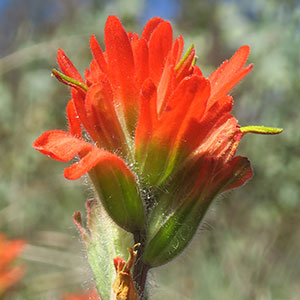|
short-lobed paintbrush
|
| Herbs, perennial, 1–5 dm; from a branched, woody caudex; with a taproot. |
solitary or few, erect or ascending, unbranched, sometimes branched, hairs spreading, short, medium, and long, soft, short and medium ones short stipitate-glandular. |
green or ± yellow, lanceolate, elliptic, or oblong to narrowly ovate, 1–2(–2.5) cm, not fleshy, margins plane or wavy, involute, (0–)3–5(–7)-lobed, apex rounded to acute; lobes ascending to erect, linear to lanceolate, apex rounded to acute. |
3–20 × 2–3.5 cm; bracts proximally greenish to dull brown, distally red, orange-red, or scarlet, sometimes orange or yellow, broadly lanceolate or oblong, (0–)3–5-lobed; lobes ascending, broadly to narrowly lanceolate, short, arising above mid length, apex acute, obtuse, or rounded. |
straight, 15–24(–26) mm; tube 12–16 mm; beak exserted, abaxial lip equal to calyx; beak adaxially green or ± yellow-green, 7–10 mm, puberulent, stipitate-glandular; abaxial lip deep green, reduced, rounded, 1–2 mm, 10–25% as long as beak; teeth incurved to erect, light green, 0.5–1 mm. |
green or whitish with green veins, lobes colored as bract lobes or paler, 14–30 mm; abaxial and adaxial clefts 5.5–8.5 mm, 30–40% of calyx length, deeper than laterals, lateral 1.5–4 mm, 20–25% of calyx length; lobes oblong to narrowly triangular, apex obtuse to rounded. |
= 24. |
|
|
|
| Flowering Mar–Aug. |
| Dry savannas, rocky slopes and open conifer forests, on serpentine. |
| 200–1700 m. (700–5600 ft.) |
|
CA; OR
|
Castilleja brevilobata is endemic to dry serpentine openings in the Siskiyou Mountains of southwestern Oregon and adjacent California. Although sometimes treated as part of C. applegatei or C. hispida, its morphology does not suggest a close connection with either. This species occasionally hybridizes with C. pruinosa in Del Norte County, California. (Discussion copyrighted by Flora of North America; reprinted with permission.) |
| FNA vol. 17, p. 591. |
| Orobanchaceae > Castilleja |
C. affinis, C. ambigua, C. angustifolia, C. applegatei, C. aquariensis, C. arachnoidea, C. attenuata, C. brevistyla, C. campestris, C. cervina, C. chambersii, C. chlorotica, C. christii, C. chromosa, C. chrymactis, C. chrysantha, C. cinerea, C. citrina, C. coccinea, C. collegiorum, C. covilleana, C. crista-galli, C. cryptantha, C. cusickii, C. densiflora, C. dissitiflora, C. disticha, C. elata, C. elegans, C. elmeri, C. exserta, C. flava, C. foliolosa, C. fraterna, C. genevieveana, C. glandulifera, C. gleasoni, C. gracillima, C. grisea, C. haydenii, C. hispida, C. hololeuca, C. hyperborea, C. indivisa, C. integra, C. kaibabensis, C. kerryana, C. kraliana, C. lacera, C. lanata, C. lasiorhyncha, C. lassenensis, C. latifolia, C. lemmonii, C. leschkeana, C. levisecta, C. linariifolia, C. lindheimeri, C. lineariloba, C. lineata, C. litoralis, C. lutescens, C. martini, C. mendocinensis, C. mexicana, C. miniata, C. minor, C. mogollonica, C. mollis, C. montigena, C. nana, C. nelsonii, C. nervata, C. nivea, C. occidentalis, C. oresbia, C. organorum, C. ornata, C. pallescens, C. pallida, C. parviflora, C. parvula, C. patriotica, C. peckiana, C. peirsonii, C. pilosa, C. plagiotoma, C. praeterita, C. pruinosa, C. puberula, C. pulchella, C. purpurascens, C. purpurea, C. raupii, C. revealii, C. rhexiifolia, C. rigida, C. rubicundula, C. rubida, C. rupicola, C. salsuginosa, C. scabrida, C. schizotricha, C. septentrionalis, C. sessiliflora, C. subinclusa, C. suksdorfii, C. tenuiflora, C. tenuis, C. thompsonii, C. tomentosa, C. uliginosa, C. unalaschcensis, C. victoriae, C. viscidula, C. wightii, C. wootonii, C. xanthotricha |
| C. hispida subsp. brevilobata |
| Piper: Proc. Biol. Soc. Wash. 33: 104. (1920) |
|


